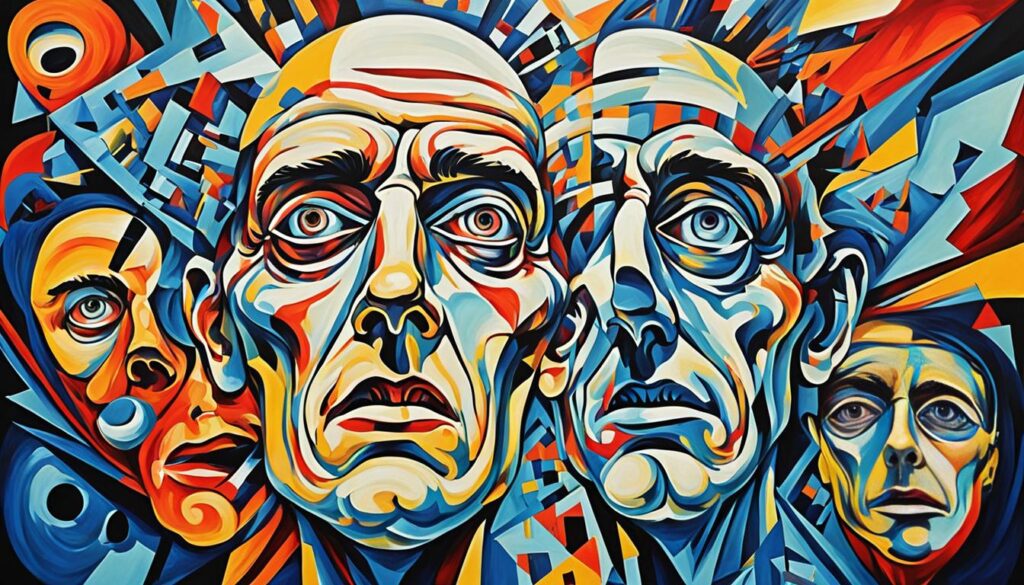Understanding Thought Disorders: Causes & Help

Did you know that thought disorders can cause confusion of thoughts, disorganized thinking, and cognitive impairment?
A thought disorder, or cognitive disorder, leads to unusual ways of expressing language. It affects how thoughts are processed. Conditions like schizophrenia, mania, and traumatic brain injury are often linked with it.
With more than 20 subtypes, each thought disorder has its own signs. This makes diagnosis and treatment a challenge. Yet, there are treatments like medication and psychotherapy. They help people manage and improve from these disorders.
What is a Thought Disorder?
A thought disorder is when someone’s thinking is disorganized. This leads to their speech and writing being abnormal. It’s a main sign of schizophrenia. But, it can also be seen in other mental issues like mania and depression. This disorder messes with how ideas are organized and processed.
Symptoms can vary but often show as a problem in connecting ideas. People with this disorder may find it hard to think clearly. They might stray off topic or say things that don’t relate. These issues make it hard for them to communicate well.
Sometimes, people might show signs of a thought disorder. But a diagnosis comes when these signs are persistent and harm a person’s everyday life and socializing. Getting evaluated and treated is key to managing this disorder.
Implications of Disorganized Thinking and Abnormal Language Expression
“Disorganized thinking and abnormal language expression can deeply affect everyday communication. Those with thought disorders often struggle to express themselves clearly. This can lead to misunderstandings and trouble in social interactions. It can hurt relationships, job chances, and the quality of one’s life.”
Recognizing Thought Disorder Symptoms
There are various ways thought disorder symptoms can show up, including:
- Loose associations and tangential speech
- Incoherence and illogicality in expressing ideas
- Circumstantiality with excessive and irrelevant details
- Pressure of speech and rapid, non-stop flow of words
- Distractability and difficulty maintaining a topic
- Clanging, where word choices are based on sound rather than meaning
These signs hint at issues in how thoughts are organized and processed. They are typical in thought disorders.
Impact of Thought Disorders on Communication
“Thought disorders significantly affect how well someone can communicate. Those with thought disorders may have trouble speaking their thoughts clearly. This can lead to issues in sharing their feelings, thoughts, and plans. As a result, communication can break down, making social interactions difficult.”
Connection with Other Mental Disorders
Though often linked with schizophrenia, thought disorders can also appear in other mental issues. In mania and depression, one might see disorganized thinking and odd ways of speaking. So, it’s critical to think of thought disorders when looking at various mental health problems.
Comparison of Thought Disorder Symptoms in Schizophrenia, Mania, and Depression
| Schizophrenia | Mania | Depression | |
|---|---|---|---|
| Disorganized Thinking | ✓ | ✓ | – |
| Abnormal Language Expression | ✓ | ✓ | – |
| Grandiose Delusions | ✓ | – | – |
| Persistent Sadness | – | – | ✓ |
Types and Symptoms of Thought Process Disorder
Thought process disorders come in different forms, each with unique signs. Knowing the subtypes helps us understand the challenges people face. Common thought process disorders include:
Alogia
Alogia means someone talks very little. This results in less speech than normal.
Blocking
Blocking is when someone suddenly stops talking. They struggle to find the words they meant to say.
Circumstantiality
Circumstantiality is giving too many details that aren’t needed. This makes communication slow and complicated.
Clanging
With clanging, a person picks words for how they sound, not what they mean. Their speech doesn’t make sense or stay on topic.
Derailment
Derailment happens when a person jumps between ideas. They don’t clearly connect one thought to another.
Distractible Speech
Distractible speech means someone can’t stick to the topic. They easily get sidetracked by other things or thoughts.
Echolalia
Echolalia is repeating sounds or words instead of saying new ideas. It’s like copying someone else’s speech.
Paraphasic Error
Paraphasic errors are when the wrong words are used. This makes the intended message unclear or wrong.
Stilted Speech
Stilted speech sounds too formal or unnatural. It lacks the easy flow of normal conversation.
Perseveration
Perseveration is saying a word or idea over and over. It doesn’t fit with the conversation anymore.
Loss of Goal
Loss of goal means someone can’t keep their main point clear. Their speech ends up vague and hard to follow.
Neologism
Neologism is when someone invents new words or phrases. These make sense only to them, not to others.
Incoherence
Incoherence is speech that’s hard to follow. It doesn’t stick to rules of logic or grammar.
Understanding these thought process disorders is important. It affects communication and sharing ideas. Knowing the symptoms helps healthcare workers support people with these challenges.
| Thought Process Disorder | Symptoms |
|---|---|
| Alogia | Poverty of speech |
| Blocking | Abrupt interruption of speech |
| Circumstantiality | Excessive irrelevant details in speech |
| Clanging | Word choices based on sound rather than meaning |
| Derailment | Talking in chains of semi-related ideas |
| Distractible Speech | Difficulties maintaining a topic |
| Echolalia | Repeating noises and words instead of expressing own thoughts |
| Paraphasic Error | Linguistic errors and incorrect word usage |
| Stilted Speech | Formal and rigid language usage |
| Perseveration | Repetitive and involuntary continuation of a word or idea |
| Loss of Goal | Difficulty maintaining a clear objective in speech |
| Neologism | Creation of new words or phrases |
| Incoherence | Speech lacking logical or grammatical coherence |
Causes and Risk Factors of Thought Disorder
Thought disorders have complex causes. They involve a mix of biology, genetics, and the environment. [causes of thought disorder, schizophrenia, mental health conditions, biological factors, genetic factors, environmental factors, risk factors] The precise reasons for thought disorders remain unclear. But, studying them reveals how these conditions evolve.
Though disorders, like schizophrenia, are seen in many mental health issues. Yet, they’re not tied to just one condition. They show up in various psychiatric problems. Knowing someone has a thought disorder means more checks and care might be needed.
Several factors can raise the chance of thought disorders. These include mood swings, depression, and even brain injuries. Stress, anxiety, drugs that change mind states, and being around harmful chemicals before birth matter too. Diseases causing body inflammation and the risk of epilepsy also play a role. [mood disorders, bipolar disorder, traumatic brain injury, anxiety, stress, mind-altering drugs, inflammatory and autoimmune diseases, toxic chemical exposure]
But, these factors don’t mean a thought disorder will definitely happen. Everyone’s risk is different, depending on their genes and what they’ve been through. Getting the full picture is key to proper treatment.
When to Seek Help for Thought Disorder
If you or someone you know has frequent or severe thought disorder symptoms, help is key. Thought disorder can be a sign of mental issues like schizophrenia. These issues often get worse without treatment.
People with thought disorders might not see their symptoms or how they affect talking. Family or friends may need to spot this. They should encourage professional help.
Watch for other signs that come with thought disorders. These include delusions, seeing things, messy thoughts or speech, and ignoring self-care. Feeling numb or pulling away from friends are also big signs.
Talking to a doctor or mental health pro is vital. They can check the symptoms, look at everything, and suggest the best way to manage it.
“Getting help early for thought disorder symptoms is key. It can make life better and improve well-being.”
No one should deal with thought disorders by themselves. Help and advice from pros can lead to the best treatment. It helps people manage their thoughts and talk better.
Thought Disorder Test and Diagnosis
To diagnose thought disorder, a medical expert reviews a person’s intelligence, background, and education. This helps determine if their thinking and communication match up. They use several tools to help diagnose thought disorders.
The Rorschach Inkblot Test
The Rorschach inkblot test is a key tool for assessing thought disorder. In this test, people describe what they see in inkblots. Their answers shed light on their thinking patterns and pinpoint thought disorder signs.
The Thought Disorder Index (TDI) or Delta Index
The Thought Disorder Index (TDI) or Delta Index checks thought disturbance severity. It uses a conversation’s speech content and flow to gauge thought disorder symptoms.
Scale for the Assessment of Thought, Language, and Communication (TLC)
The TLC Scale evaluates thought disorders by focusing on language and communication. This tool helps diagnose thought disorder signs and guides treatment decisions.
These diagnostic tools are crucial for understanding and treating thought disorders. They give insights into a person’s thought patterns, aiding in customized care plans. With this knowledge, healthcare workers can deliver the best support.
Image: A thought disorder test being administered by a medical professional.
Thought Disorder Treatment
The goal of thought disorder treatment is to tackle the root cause of the symptoms. There are two main methods used: medication and psychotherapy.
Medication: Doctors often prescribe antipsychotics to help balance brain chemicals. These drugs can ease symptoms of thought disorders. They make thinking clearer, boost communication, and handle other symptoms.
Psychotherapy: Therapy, especially cognitive-behavioral therapy (CBT) and cognitive enhancement therapy, is useful. CBT teaches patients to change negative thoughts into realistic ones. It also shows how to deal with the illness. Cognitive enhancement therapy improves thinking and social skills with special programs.
Life Skills Training: This training helps a person manage everyday tasks and problems. It boosts independent living, problem-solving, and social skills.
Social Support: Having a support network is key for those with thought disorders. Family therapy, support groups, and peer support offer emotional backup, advice, and tips for coping with thought disorder challenges.
“Medication and psychotherapy are the mainstays of thought disorder treatment. Antipsychotic medications can balance brain chemicals, while therapy helps individuals develop coping strategies and improve cognitive functioning.”
A well-rounded treatment plan can lead to symptom relief for those with thought disorders. It can improve communication, social skills, and overall life quality.
Common Thought Disorder Subtypes
Thought disorders show up differently in everyone. Knowing the common subtypes helps us understand their symptoms better. The two main types are positive thought disorder and negative thought disorder.
Positive Thought Disorder
Positive thought disorder adds behaviors or symptoms not found in healthy conditions, especially in schizophrenia. People with this disorder might have hallucinations. This means they see, hear, smell, taste, or feel things that aren’t really there.
They may also act in disorganized ways. This includes repetitive movements, acting inappropriately, or looking unkempt. It’s hard for them to organize their thoughts, making their speech unclear.

Negative Thought Disorder
Negative thought disorder is when someone shows less mental or emotional activity than usual. Individuals might not react much emotionally. They might seem distant or indifferent. They find it hard to show or talk about their feelings. Their facial expressions don’t change much, even when they should.
It also makes speaking less common or not at all. This issue, known as alogia, shows up as short answers or hardly talking. Their speech overall is less frequent.
Variability in Symptoms
Thought disorders vary from person to person. The symptoms’ severity and how often they occur can differ. Some might have both positive and negative symptoms, while others have symptoms more in line with one type. Understanding these subtypes can help in early detection and in choosing the right treatment.
| Subtype | Characteristics |
|---|---|
| Positive Thought Disorder | Hallucinations, disorganized behavior |
| Negative Thought Disorder | Limited emotional response, lack of speech |
Understanding the Signs of Thought Disorder
It’s vital to know the signs of thought disorder for the right help. Signs point to the presence of this disorder:
Speech gets disrupted: Loose thoughts make talking incoherent. Tangential speech, filled with off-topic info, is also common.
Talking becomes senseless and illogical. This shows thought disorder in action.
Too many details muddle the point. This makes smooth chatting hard.
Some speak fast and non-stop. It’s hard for others to follow.
Focus shifts quickly, causing scattered talks.
A key sign is clanging: choosing words for their sounds, not their meanings.
Spotting these signs aids in diagnosing thought disorder. It leads to the right treatment.
An Example Case Study: Sarah’s Disruptions in Speech
We’ll study Sarah, 27, to see thought disorder signs. Sarah’s speech is all over the place. She hops from topic to topic illogically. Her talks are sidetracked by unrelated details. Following her thoughts is tough.
| Signs of Thought Disorder | Description |
|---|---|
| Disruptions in Speech | Sarah’s speech is scattered and incoherent. She shifts from one topic to another without clear links. |
| Tangentiality | She fills conversations with unneeded information, missing the main point. |
| Incoherence | Sarah’s speech makes little sense and lacks a logical flow. It’s hard to grasp her message. |
| Illogicality | Her conclusions are hard to follow because they miss logic. |
| Circumstantiality | She dwells on details, delaying the conversation’s key points. |
| Pressure of Speech | Sarah talks fast and non-stop, making it hard for others to speak up. |
| Distractability | Her attention flits, leading to fragmented and broken speech. |
| Clanging | Sarah’s word choice is based on sounds, complicating understanding further. |
This study shows how Sarah’s speech uncovers thought disorder signs. Through recognizing these signs, health experts can correctly diagnose and create helpful treatments for people like Sarah. They can help her improve her thought patterns and talk more clearly.
Causes and Risk Factors of Thought Disorder
The exact causes of thought disorders are unknown. Scientists believe they stem from brain issues, genetics, and the environment. Studies link thought disorders like schizophrenia to issues in how the brain handles meaning. Sleep problems, too much overthinking, and certain environmental triggers raise the risk.
Changes in the brain play a big part in thought disorders. Research has found differences in the brains of people with these disorders. These changes can make it hard for the brain to organize thoughts, leading to confused thinking and speech.
Family history affects the risk of thought disorders. If thought disorders run in your family, you’re more likely to develop them too. Researchers are studying specific genes to understand their role in these disorders.
Life’s hard times, like trauma, can start symptoms of thought disorders in some people. Using drugs that change the mind is also a factor. These life conditions can trigger or worsen thought disorders.
Not getting enough sleep or poor sleep can harm how we think. It affects the brain’s ability to handle information. This can cause or worsen thought disorders.
Overthinking negative thoughts is linked to thought disorders. Always focusing on the bad can twist thinking. It makes clear, logical thinking harder.
Everyone might struggle with talking or writing clearly at times due to stress or not sleeping well. But when it happens a lot and causes problems, it could be a thought disorder.
Understanding what causes thought disorders can aid in treating them. Addressing brain issues, genetic links, and triggers can improve life for those affected.
Diagnosis and Assessment of Thought Disorder
Healthcare professionals use various tools to diagnose thought disorders. These tools help figure out how severe the symptoms are. Among these are the Scale for Assessment of Positive Symptoms (SAPS) and others.
The SAPS looks into positive symptoms like hallucinations. Meanwhile, the SANS focuses on negative symptoms, like limited speech.
The FTD-S lets individuals rate their own symptoms. This self-report helps give clinicians a clear picture of the patient’s view.
The TLC checks how well a person can express and understand language. It sees if thoughts and language are used correctly in different situations.
The Rorschach inkblot test analyzes how someone interprets ambiguous images. It offers deep insights into someone’s thought process.
Before saying someone has a thought disorder, doctors must eliminate other causes. This ensures the diagnosis is correct.

Assessment Tool Observations SAPS Presence of auditory hallucinations and delusional beliefs. SANS Restricted emotional expression and reduced speech output. FTD-S Self-reported symptoms of disorganized thinking and abnormal language expression. TLC Impaired thought organization and communication difficulties. Rorschach Unusual and idiosyncratic interpretations of inkblots.
After looking at the tools’ findings, doctors can diagnose thought disorder. They can then plan the best treatment.
Conclusion
Beating thought disorders is totally possible when you have the right plan. It’s super important to get professional advice and the correct diagnosis. This way, you can get treatment that really suits you.
Medicines like antipsychotics and therapy, especially cognitive-behavioral therapy, are often used. They help people think clearer and communicate better. These treatments address what causes thought disorders and teach ways to handle symptoms.
Support from others is also key in overcoming these disorders. Family therapy and support groups offer a place to share stories and get support. They provide encouragement from folks who understand what you’re going through.
With the correct diagnosis, a good treatment plan, and strong support, progress is within reach. People can get better at dealing with their thought disorders. Then, they can take charge of their lives and live them to the fullest.






